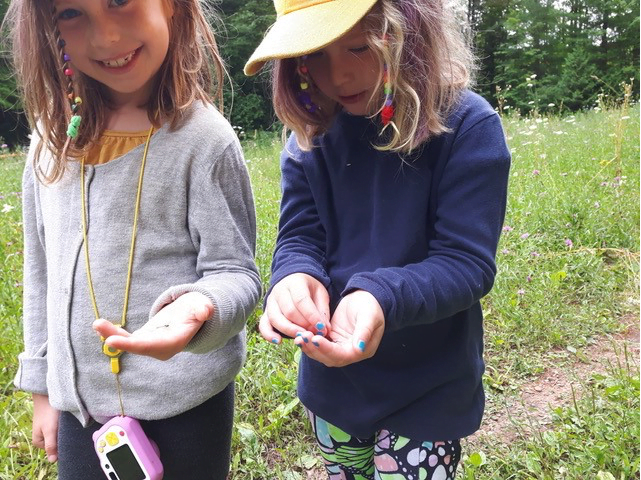By Sibylle Walke
At the end of July we took our grand daughters Isla 4 and Petra 6 to the 13th annual dragonfly hike of the Saugeen Naturalists at Allen Park, having chased “damsels and dragons “ with hike leader John Reaume at McGregor Park and the Krug forest in previous years. Meeting nine participants in all John equipped everyone with a proper (long socked) net to enable all to safely catch, remove and hold damsel and dragonflies for a good look before releasing them back into their hunting grounds.

Starting the search on the margins of the pond on a cool and overcast morning the solar powered dragonflies proved elusive at first, so we paid attention to site specific flora such as swamp milkweed and ascertained other flora with the help of the “seek” app ,which is connected to the citizen’s scientist site “iNaturalist”.

A Pickerel frog, which looks similar to the common leopard frog, but has blotches organized in rows and yellow insides of the legs was caught for a look as well as two diminutive spring peepers. It is unbelievable that these tiny chaps put up a peeping chorus during spring mating, which can be heard for kilometres around. Afterwards they move from wet areas into the trees and are not easy to spot.
Luckily no arachnophobes were on the hike as John shared his fascination and vast knowledge of spiders by picking out just three discoveries from the multitude along the wayside: we found a Goldenrod Crab spider on a Queen Ann’s Lace flower looking almost white. This spider is capable of changing colour between white and yellow to mask itself according to environment. A female Bowl-and-doily spider was hunting on its two layered net, allowing her male companion to hunt below, a friendly but not a frequent arrangement among spiders.
We also admired a Candy-striped Spider. John’s description of the spider moving out her elaborate mouthparts and how biting a human hand would be like biting a wall, elicited great hilarity among the children.

Not many dragonflies hunt in shady areas and forests, though some such as ebony jewelwings specialize in dappled leafy places along slow moving water. In a forest clearing as the temperature rose we finally caught multiple damselflies. They are distinguished from dragonflies by the way they hold their wings together when at rest, their needle-like slim bodies and sideways elongated heads with eyes at each end of the “hammerhead”. Dragonflies have sturdy torsos, round heads, their eyes are out front and touch and they keep their wings out when landed.
Everyone caught various meadowhawks and Eastern Forktails. We heard about their intricate mating strategies, which explains how we may see them in tandem or wheel formation flying about. Their distinguishable interlocking genitals allow not only to tell male from female but also are the key to identifying species.
On our way to our final destination, the tall grass prairie, we passed the pond once more and squeezed by a sizeable northern water snake , much to the horror of my older grand daughter. The snake was confidently sunbathing and there we caught one beautiful Violet Dancer, the long spines on its legs distinguishing it from other pond damsels.
I was drawn to and fascinated by the tall grass prairie, which was established at Allen Park through a planned burn and the planting of specific indigenous grasses and flowers. This landscape was very common around the Great Lakes basin, but has all but disappeared. The sun was out and the heat brought out the dragons. They are the fastest and most nimble insect flyers so it took quite a pursuit to catch at least one Halloween Pennant, even if we could see the larger dragonflies flitting about at distance.
It was a beautiful outing and though the girls were wondering where the swings and monkey bars were at first, they gained a lot of courage and confidence within a couple of hours. Petra didn’t loose her archaic fear of snakes, but she learned that they don’t attack. They still feel itchy when just walking through a mosquito area, but they loved hearing about the realm of insects and spiders, catching and holding damselflies and the odd spittle bug as well.



